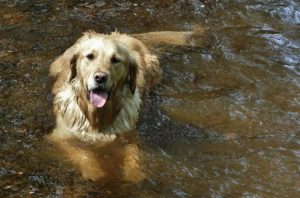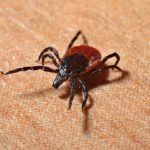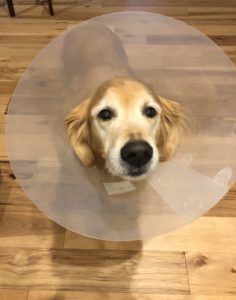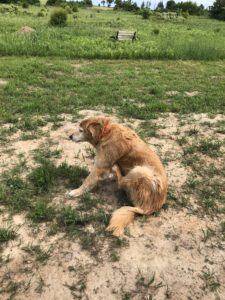If your dog gets hot spots, it can be stressful for you and your dog and it is very painful for your dog. If your dog has never had hot spots, it doesn’t mean that they might not still get them, so it is good to be informed ahead of time. So what is dog hot spots?
I am going to take a look at why dogs get hot spots, the symptoms that you will see with hot spots, who gets hot spots, dog hot spots treatment, and how to prevent hot spots.
Table of Contents
What Is Dog Hot Spots
A hot spot on your dog is a superficial skin infection. It happens when normal skin bacteria overruns the skin’s defenses because of damage to the surface. A hot spot is when the skin is moist and your dog has a raw skin disorder.
There are many causes for hot spots, but the most common factor is bacteria. If the skin breaks, it creates an environment for bacteria to form when the skin is moist. The moisture can come from a bath, swimming or walking in the rain. It is then further irritated by your dog licking, chewing or scratching the area.
Anything that irritates the dog’s skin enough for them to scratch or lick themselves excessively can start a hot spot. It can be from a bug bite, an allergic reaction, a mite or flea or tick bite, or poor grooming with matted fur.
Constant licking or chewing can also be from stress or boredom.
Symptoms Of Hot Spots
Hot Spots will usually occur on the head, hips or chest area. They will be hot, moist, red and inflamed by the dog’s repeated licking, chewing, gnawing and scratching. Check your dog over closely if you notice them doing this incessantly.
There will be loss of hair in the affected area and it will become painful to the touch.
Eventually, pus will ooze out. The dried pus and damaged skin surface will form a hard crust and you will notice the fur around the area becoming matted down from the pus.
It can spread very quickly if untreated and is very painful for the dog. The whole process can happen within a few minutes.
Who Will Get Hot Spots?
Dogs who are not groomed regularly and have matted, dirty coats are prone to hot spots, since the moisture isn’t getting away from the skin. Also, thick coated long haired breeds are more at risk for hot spots. Anything that can cause irritation to the skin, can have the effect of getting a hot spot.
If your dog has a hot spot in the hip area, it could be flea infestation, hip arthritis, or an anal gland infection. Near the ears could indicate an ear problem, an allergy or a dental irritation. Your vet will be best for determining what could be the cause.
Dogs who are wet a lot can also have problems. It could be from swimming or being in the rain, and their fur not dried off properly. The wet fur against their skin can increase their chances of developing hot spots.
Long haired or thick coated breeds like Golden Retrievers, St. Bernards, German Shepherd, Labrador Retrievers and Rottweilers are known for having problems with hot spots, but really most breeds could develop hot spots.
It is also more likely to happen during the summer. When there is hot weather and high relative humidity. Your dog will have more issues with moisture on their skin.
If you have a dog who isn’t getting enough exercise and mental stimulation, it could just be pure boredom that is causing your dog to chew and gnaw on themselves.
Your dog could also be upset about being home alone or suffer from separation anxiety. This will also cause dogs to continue to lick and chew on themselves, possibly causing a hot spot to occur. You actually need to keep your dog stress free to help keep them healthy.
Treatment Of Hot Spots
The most important thing is to try to figure out what is causing your dog to have a hot spot. If you don’t figure out the reasoning behind the hot spot, you can treat the current hot spot, but chances are that the hot spot will continue to return.
If it is related to ticks or fleas, make sure that you get your dog on some preventable medicine to avoid this. Either with a tick and flea collar or using Frontline. The bites from ticks and fleas can cause your dog to lick and chew on themselves until they develop a hot spot.
with a tick and flea collar or using Frontline. The bites from ticks and fleas can cause your dog to lick and chew on themselves until they develop a hot spot.
If you catch your dog’s hot spot very early, and it is a very small area, you might be able to treat at home, but it is best to check with your vet for their recommendation.
There are over-the-counter products made for dogs that can be effective depending on the severity of the problem. There are topical sprays and medicated shampoos that are available.
There is also Restore Salve and Hot Spot care made by Farm Dog Naturals. This is a natural product that has great ingredients that can help with a wide range of issues on your dog’s skin. It treats bug bites, flea dermatitis, is an excellent remedy to heal cuts, scrapes, punctures and open wounds. A good all around product to have on hand for your dog’s medical issues.
At Home Treatment
- Clip the fur covering the area to allow air and medication to reach the affected area.
- Keep your dog from licking or scratching the area. The best and probably the only safe way is to use the Elizabethan Collar, also known as the cone of shame. It will not heal, and will continue to get worse if your

Not happy wearing his new accessory.
dog continues licking, chewing or scratching the infected area.
- Apply a warm, moist washcloth to the area 3 times per day for 5-10 minutes to help keep it clean. Allow to dry completely before applying any topical medications.
- Do not use any bandages or wraps on the affected area. It needs to breathe to heal.
- You need to remove whatever caused the hot spot to begin with, or it will happen again.
Vet Treatments
- Your veterinarian will shave your dog’s fur around the lesion to allow better air flow and to allow the medication to reach the wound better.
- They will clean the skin.
- You will receive antibiotics and most likely painkillers, since it is very painful for the dog.
- They will instruct you to use the Elizabethan Collar. I strongly recommend that you use it until it is completely healed, or you will be starting all over again with the healing process.
- They will prescribe corticosteroids and antihistamines to help control the itching.
How To Prevent Hot Spots
- Groom your dog on a regular basis.
- Keep dog’s fur clipped short in warmer months.
- Be on a strict flea and tick program.
- Be sure to provide your dog with a stress-free environment.
- Make sure your dog gets plenty of daily exercise, avoid dog boredom, and make sure your dog gets plenty of interaction with the family.
Summary
It is really important that you figure out why your dog gets hot spots to help avoid them getting them in the future. You need to figure out if your dog has food allergies, and if so, you need to change your dog’s food to something  that won’t affect them.
that won’t affect them.
Has your dog had issues with fleas or ticks? If so, make sure that you have a preventative plan in place for flea and tick protection with Frontline or some other method.
Is your dog bored, not getting enough exercise or not spending enough time with the family? These are all reasons that your dog could develop a hot spot.
It is best to at least consult with your veterinarian if your dog develops hot spots to get their evaluation of how to best handle getting your dog healthy.
From personal experience, I strongly recommend making your dog where the cone collar. I had a hard time doing it myself, since my dog got so upset, but the first time he re scratched it and was a bloody mess, made me get strong and make my dog wear it. Also, keep it on until they are completely healed. It can be looking good and your dog won’t seem to pay any attention to the hot spot, and when you remove the collar, they can quickly put themselves back to the beginning of healing.
Dogs are their worst enemy when it comes to hot spots. They just aren’t able to leave them alone, which makes healing a long process and stressful for everyone.
If you have any questions or comments, please leave them below. Any suggestions that you have found to work well are also welcome to be shared with everyone.
Some of the links within this post are Affiliate Links, of which I might receive a small compensation from sales of certain items. It in no way affects the price that you would pay.

My older dog has horrible allergies and he continually licks and scratches which cause an infection. Can I also use this treatment for this? He gets daily allergy pills and I bathe him with vet recommended shampoo, but that really does not stop him LOL
First of all, I am sorry your dog has bad allergies. I had a dog that was the same way, and he would chew all his fur off his paws. It isn’t pleasant. Yes, you would be able to use this treatment and I believe that you would give your dog some relief from all his scatching. Have you ever considered changing your dog’s food. Many ingredients in dog food will contribute to dogs having allergies. Take a look at this article and you might find something that will help. https://justforyourdog.com/what-is-the-best-dog-food-for-dogs-with-allergies-grain-free-dog-food
Thanks for reading my article and I hope you can find some relief for your dog.